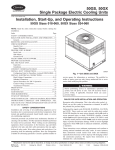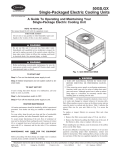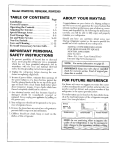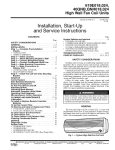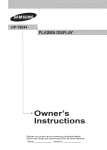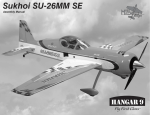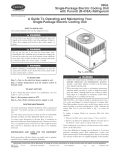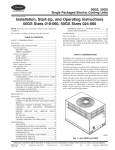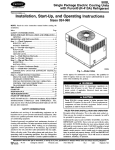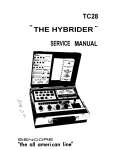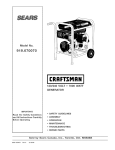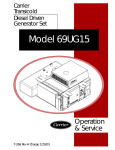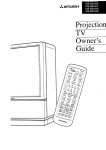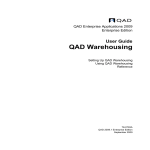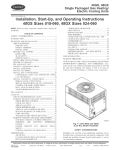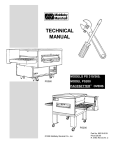Download York 018-060 User`s manual
Transcript
NFATUNG
50GS, 50GX
EMectric CooMing Units
& COOLING
SingMe Packaged
\isit _ _ ?_ carrier.corn
Installation, Start-Up, and Operating
50GS Sizes 018-060, 50GX Sizes 024-060
NOTE:
Read
installation.
This symbol
the entire
-->indicates
instruction
a change
manual
be%re
starting
since the last issue.
TABLE OF CONTENTS
SAFETY CONSIDERATIONS
1
Introduction
2
RE( EIVING AND INSTALLATION ..........................................
(beck Equipment ......................................................................
IDENTIFY UNIT ................................................................
INSPECT SHIPMENT ........................................................
2
2
2
2
Provide Unit Support ................................................................
ROOF (LTRB .......................................................................
SLAB MOUNT .................................
GROE_D MOL_T ...............................
Provide Clearances ...................................
Field Fabricate Ductwork ..........................
2
2
2
2
2
2
Rig and Place Unit ...................................
2
INSPE( TION ...................................
3
INSTALLATION ................................
3
Connect Condensate Drain ...........................
5
Install Duct Connections ............................
6
CONFIGURING [NITS FOR DOVv_FLOW
(VERTICAL) DISCHARGE ..............................
7
Install Elect*ical Connection ...........................
9
HIGH-VOLTAGE CONNECTIONS .................
9
SPE(IAL PRO(EDURES FOR 208-V OPERATION,
l0
CONTROL VOLTAGE CONNECTIONS ............
l0
STANDARD CONNE( TION
10
TRANSFORMER PROTECTION
i0
PRE-START-UP
METERING DEVICE
ACUTROL DEVICE ........
LIQUID LINE STRAINER ......................
the
24
24
Troubleshooting .....................................
24
Start=[ p Checklist .....................................
24
NOTE TO INSTALLER
Before the installation, READ THESE
INSTRU(TIONS
CAREF[LLY
AND (OMPLETELY
Also,
make sure the User's Manual and Replacement Guide are left with
the unit after installation
SAFETY
Installation
hazardous
trained
and servicing
of air-conditioning
due to system pressure
and qualified
air-conditioning
Unhained
equipment
and electrical
personnel
should
install,
can perfb_n
basic
attached
all safety
quenching
available
Only
or service
functions
should
of
be performed
service personnel.
When working
on air-conditioning
observe precautions
in the literature,
tags, and labels
to the unit, and other
Follow
repair,
maintenance
coils and filters. Al! other operations
by trained
equipment,
can be
components
equipment.
personnel
cleaning
service
CONSIDERATIONS
codes.
Wear safety
cloth fbr unbrazing
fk)r all brazing
agency
or agency
sories
when modifying
must
precautions
glasses
operations.
operations.
fk)r infornmtion
staller
safety
Consult
that may apply.
and work gloves. Use
Have
fire extinguisher
a qualified
or assistance.
The
use only factory=authorized
installer
qualified
or
in-
kits or acces-
this product.
!0
START-UP
13
CHE(K FOR REFRIGERANT LEAKS
13
START UP < OGLING SECTION AND MAKE ADJUST°
MENTS .........................................
13
CHECKING (OGLING CONTROL OPERATION .... 13
CHECKING
AND
ADJUSTING
REFRIGERANT
CHARGE .....................................
14
INDOOR
AIRFLOW
AND
AIRFLOW
ADJUST°
MENTS ......................................
14
For 208/230V .................................
!4
FOR 460-V GE MOTORS .........................
14
COOLING SEQ[ EN(E OF OPERATION ..........
16
MAINTENANCE ...................................
18
AIR FILTER .................................
22
EVAPORATOR BLOWER AND MOTOR .........
22
CONDENSER (OIL, EVAPOP, ATOR COIL, AND CONDENSATE DRAIN PAN ........................
23
CONDENSER FAN ..............................
23
ELECTRICAL CONTROLS AND WIRING .........
24
REFRIGERANT CIRCUIT ......................
24
EVAPORATOR AIRFLOW ......................
24
Manufacturer
reserves
PC 101
the right
to discontinue,
CatNog No. 535-00078
or change
C99001
Fig. 1--Unit
at any time, specifications
Printed in USA
Form
or designs
50GS.GX-3SI
without
notice
Pg 1
80GS
and 80GX
and without
11-02
incurring obligations.
Replaces:
50GS,GX-2SI
SLAB
MOUNT
Place the unit on a solid,
Be%re
system,
power
personal
per%truing
mm
service
off power
switch,
or
maintenance
to m_iL Turn
if applicable.
Electrical
operations
on
off accessory
heater
shock
cause
can
injury.
4 in. thick with
extend
approximately
GROUND
Understand the signal words DANGER, WARNING, CAUTION,
and NOTE. These words are used with the safety-alert symbol.
DANGER identifies the most serious hazards which will result in
severe personal ir!imy or death. WARNING signifies a hazard
which could result in personal injury or death. CAUTION is used
to identify unsafB practices which would result in minor personal
injury or product and property damage. NOTE is used to highlight
suggestions which will result in enhanced installation, reliability_
or operation.
prepared
These instrucfions cover minimum requirements and confbrm to
existing national standards and safety codes. In some instances,
these instructions exceed certain local codes and ordinances,
especially those that rnay not have kept up with changing residential constroction practices. We require these instn/ctions as a
minimum fbr a saf_ installation.
in. above
_NTRODUCTION
The 50GS and 50GX units (see Fig. 1) are fully self:contained, and
designed for outdoor installation. See Figs. 2 arid 3 for unit
dimensions. All unit sizes have discharge openings for both
horizontal and downftow configurations, and are factouj shipped
with all downflow duct openings covered. Units may be installed
either on a rooftop, ground-level cement slab, or directly on the
ground if local codes permit. (See Fig. 4A fbr roof curb dinaen=
sions.)
with gravel
Adequate
and
comer
or under
under
partial
overhang
the unit
the
unit
clearances
directly
on
on the
level
are shown
air
must
overhang
provide
obstruction.
be
ground
in Fig. 2 & 3.
provided.
must
rnaximum
not exceed
a minirnm*n clearance
INPORTANT:
at either
The
detrimental
outdoor=air
Do not place
or flood
carpeting
combustible
should
levels.
extension
of a
48 in. For extended
airflow.
or
fire
the unit where water,
other
is 36
horizontal
overhangs,
the
An air restriction
discharge
may
be
lift.
or roof will damage
or
overhang)
outdoor
inlet
to compressor
clearance
house
of 48 in.
Do not restrict
the
The rninimum
(such as a nomaal
top. The
ice, or snow fiom an overhang
the unit.
Do riot install
materials.
the unit
Stab=mounted
on
units
be at least 4 in. above the highest expected water and nmoff
Do not use unit if it has been under water.
Step
4-==Field
Secure
Fabricate
a11 ducts
discharge
units
Ductwork
to roof
curb
arid building
Do t_nf connecf
with counter
codes.
Ducts
passing
and covered
all external
flashing
through
comply
with
Step 2--Provide
should
handle
When
working
exceed
-.25 in. wg.
Step
5--Rig
Rigging
reasons
ductwork,
and
joints,
and roof openings
in accordance
barrier.
with
space
If a plenum
be ducted
fire codes.
ductwork.
on vertical
with flanges
on the horizontal
be secured to the flanges. Insulate
should
applicable
around
stnlcmre
to _mir For horizontal
an unconditioned
with a vapor
required
duct_ork
and mastic
Inspect for shipping damage while unit is still on shipping pallet
If unit appears to be damaged or is torn loose from its anchorage,
have it examined by tlansportation inspectors before removal
Fopxard claim papers directly to transportation company Manu=
facmrer is not responsible for any damage lucre'red in transit
(heck all items against shipping list Immediately notif}- the
nearest Can'ier Air ( onditioning office it"any item is missing. To
prevent toss or damage, 1cave all parts in original packages until
installation
applicable
must be insulated
remm
through
is used
on a
the roof deck to
A rninimun_
Cabinet
clearance
retort>air
static
is not
shall
not
Pmaee Unit
and handling of this equipment
due to the installation
location
can be hazardous for many
(roof?_, elevated stn/cmres,
etc.)
Only
trained,
literature,
qualified
Follow
crane
and install
with
all applicable
operators
and ground
support
staff
this equipment.
this equipment,
on tags, stickers,
and any other safety
gloves.
required
by
discharge.
outdoor
an overhead
a partial
unit, the return
Cm'b should be level to within 1/4 in. (See Fig. 5A). This is
necessary fbr unit drain to fhnction properly. Refer to accesso W
roof curb installation instructions fbr additional infbm_ation as
of the
required
outdoor fhn &aws air through the outdoor coil and discharges
it
through the top fan grille. Be sure that the fan discharge does not
recirculate
to the outdoor coil. Do not locate the unit in either a
vertical
mMPORTANT: The gasketing of the unit m the roof cm'b is critical
for a watertight seal. Install gaskefing material supplied with the
roof curb. Improperly applied gasketing also can result in air teaks
and poor unit perfbrmance.
Place
service
ventilation
and weatherproof
Install accesso U root" curb in accordance with instructions shipped
with curb (See Fig. 4A) Install insulation, cant strips, roofing, and
flashing. Ductwork must be attached to curb
when
Clearances
minimum
IDENTIFY UNIT
Unit Support
on all 4 sides
on a slab or placed
permit.
applications,
unit is provided
openings. All ductwork
should
ROOF CURB
the casing
for condensate
a--Provide
)"he required
either
codes
RECEBVING AND INSTALLATION
Step 1--Check Equipment
The unit model number and serial number are stamped on the unit
identification plate. Check this infbrmation against shipping pa=
pers
INSPE( T SHIPMENT
of
MOUNT
if local
Step
pad that is a minimurn
(See Fig. 5B). The slab should
the unit to the slab except
The unit may be installed
ground
grade
2 in. beyond
unit. Do not secure
local codes.
Recognize safety information. This is the saf?ty-alert symbol_
When you see this symbol in instrucfions or manuals, be alert to
the potential fbr personal injury.
level concrete
2 in. above
precautions
safety
observe
and labels
that might
codes.
precautions
attached
Wear
in t!-le
to the equipment,
apply.
safety
shoes
and work
D /ENS!ONS
it\
[]
ARE
IN
INCHES
_EV_ORa_CO!L
706
[2 78]
{
[16
OR]406 4
402 O
[15 83]
4
CONDENSER
17 7
63)
_249
6_550
[9 83]
88 ;/
[3 48]
TOP ViEW
[21
5
2496
67]
[9
83]
REAR VIEW
IIR39
\
b
2263
[48 28]
i..
1222
[4 8!
so
0
20)
RHOHT SHDE VmEW
FRONT VHEW
REQUHREDCLEARANCE TO COMBUSTHBLEMATL.
._
REQUHREDCLEARANCE FOR OPERATION AND SERVHCBNG
INCHES [mm]
1400 [355 6]
.200 [50.8]
1400 [355 6]
.050 [12.7]
3600 [914 4]
TOP OF UNIT ..................................................
DUCT SIDE OF UNIT ............................................
SIDE OPPOSITE DUCTS ..............................................................
BOTTOM OF UNIT ................................................
ELECTRIC HEAT PANEL .......................................
INCHES [mm]
3&00 [914.0]
4200 [106&6]
EVAR COIL ACCESS SIDE. ........................................
POWER ENTRY SIDE. ................................................
(EXCEPT FOR NEC REQUIREMENTS)
UNIT TOP ...................................................................
SIDE OPPOSITE DUCTS ...........................................
DUCT PANEL .......................................................................
4&00 [!21&2]
3&00 [914_0]
1200 [304_8] *
NEC. REQUIRED CLEARANCES.
INCHES [mm]
BETWEEN UNITS, POWER ENTRY SIDE ................................... 4200 [1066 8]
UNIT AND UNGROUNDED SURFACES, POWER ENTRY SIDE 3600 [914 0]
UNIT AND BLOCK OR CONCRETE WALLS AND OTHER
GROUNDED SURFACES, POWER ENTRY SIDE ........................ 4200 [1066 8]
_MINIMUM
WALL
DISTANCES:
IF UNF
IS PLACED
LESS
SYSTEM,
THEN SYSTEM
PERFORMANCE
THAN 3048
[12.00] FROM
MAYBE COMPROMISE
C99007
UNIT WEIGHT
CENTER OF GRAWTY
iN. (NM)
Y
UNIT HEIGHT
IN. (MM)
UNIT
EL_=CTRICAL CHARACTERBSTICS
80GS0t8
208/230-1-60
lb.
254
kg
115.2
35.02 (889.5)
20.0 (508.0)
13.0 (330.2)
15.0 (381.0)
80GS024
208/230-1-60
260
117.9
35.02 (889.5)
19.0 (482.6)
13.0 (330.2)
15.o(381.o)
258
117.0
35.02 (889.5)
19.0 (482.6)
14.o (355.6)
laO (381.o)
80GS030
208/230-1-60,
208/230-3-60
X
_A_
Z
SOGS03G
208/230-1-60,
208/230-3-60,
460-3-60
268
121.6
37.02 (940.3)
2010 (508.0)
14.o (355.6)
13.o (330.2)
80GS042
208/230-1-60,
208/230-3-60,
208/230-1-60
460-3-60
294
133.3
35.02 (889.5)
19.0 (482.8)
14.o (355.6)
13.o (330.2)
270
122.5
37.02 (940.3)
18.5 (469.9)
14.5 (368.3)
16.o
291
132.0
39.02 (991.1)
19.5 (495.3)
15.5 (393.7)
17.6 (447.0)
299
135.6
35.02 (889.5)
19.5 (495.3)
15.25 (387.4)
16.5 (419.1)
80GX024
80GX030
50GX035
208/230-1-60,
208/230-1-60,
208/230-3-60
208/230-3-60,
460-3-60
(40614)
Fig. 2-- 50GS018o042 and 50GX024o036 Unit Dimensions
of wear,
should
Accessory
units wNch
holds.
lifting kit is only to bc usd
have a composite
with Small
Packaged
base pan with molded
rigging
to initial
deformation,
or
wear
cracks
Particular
at hoist hooking
attention
points
and toad
support areas Brackets or straps showiug any kind of wear in (hose
areas must not be used and should be discarded
INSTALLATION
INSPECTION
Prior
structural
be paid to excessive
1
use, and at mommy
and straps should
bc visually
intervals,
inspected
all rigging
_br any damage,
Position
the lifting
brackets
m-dr. Leave
evidence
spreader
bar
the top
bracket
assembly
shipping
skid
Be sure the strap does
around
on
the base
the unit
not twist.
of the
to act as
a
DIMENSONS
r 2
]
RI
R
{] ARE N
NCHES
URN
1!6_00_
4000
C01L
880
[3 481
TOP VIEW
COMPREGSORIBLOWER,ELECTRIC IiEAT
& ELECTRIC ACCESS
REAR VIEW
\
\
I}93
9
[47003
_0006
[42 94]
POWR ENTRY
?
i
202
J
I
J
j
[088]
OIA HOLE
CON [ROL ENIRY
'I
6202
[Z4 42]
I [(21J
02GI
_ ..........
[12 84]
%
ii
1343]
• 4 \\
[44
22i
\
VIEW
DIIAI[_ OUIL[I
190
[0¸?5)
N PT
_2_o_o8._
FRONT VIEW
REQUIRED CLEARANCE TO COMBUSTIBLE MATL
REQUIRED
TOP OF UNIT ...................................................................................
DUCT SIDE OF UNIT .........................................................................
BIDE OPPOSITE DUCTS ................................................................
BOTTOM OF UNIT .............................................................................
ELECTRIC HEAT PANEL .................................................................
REQUIRED
BETWEEN
UNIT AND
UNIT AND
GROUNDED
50
[0 20]
_
\\
LEFT SIDE
NEC.
i02 ?
[481}
_2263
[48 28]
INCHES
1400
200
1400
050
3600
[mm]
[355 6]
[50.8]
[355 6]
[12.7]
[914 4]
RIGHT SIDE VIEW
CLEARANCE
FOR OPERATION
AND
SERVICING
EVAR COIL ACCESS
SIDE ............................................................
POWER
ENTRY
SIDE ....................................................................
(EXCEPT
FOR NEC REQUIREMENTS)
UNIT TOP .......................................................................................
SIDE OPPOSITE
DUCTS
..............................................................
DUCT PANEL
.................................................................................
INCHES
36.00
36.00
48.00
36.00
12.00
[mm]
[914.0]
[914.0]
[1219 2]
[914.0]
[304.8]
*
CLEARANCES.
UNITS,
POWER
ENTRY
SIDE ....................................
UNGROUNDED
SURFACES,
POWER
ENTRY
SIDE
BLOCK
OR CONCRETE
WALLS
AND OTHER
SURFACES,
POWER
ENTRY
SIDE
INCHES
42.00
.36.00
.........................
42.00
_MINIMUM DISTANCES: IF UNIT IS PLACED LESS THAN 3048 [12 00] FROM
WALL SYSTEM, THEN SYSTEM PERFORMANCE
MAYBE COMPROMISE
[mm]
[1066 8]
[914.0]
[106B
8]
C99006
UNIT
ELECTRICAL
CHARACTERISTICS
UNIT WEIGHT
UNIT HEIGHT
lb.
324
kg
145
38.98
IN, (MN)
"A"
50GS048
208/230-1-60,
208/230-%60,
50GS060
208/230-1-60,
208/230-3-60,460-3-60
389
176
38.98 (990.2)
50GX042
208/230-1-60,
208/230-%60,460-%60
321
146
38.98 (990.2)
50GX048
208/230-1-60,
208/230-%60,
460-%60
326
148
38.98 (990.2)
80GX060
208/230-1-60,
208/230-%60,
460-%60
399
181
42.98 (1091.1)
460-%60
Fig. 3-- 80GS048-060
2, Place each of the _bur (4) metal lifting brackets
rigging holds inthe composite pan
(990.2)
and 80GX042-060
into the
3, Tighten the ratchet strap unit tight, Lifting b*ackets should be
secure inthe rigging holds
4, Attach the clevis or hook of sufficient strength to hole in the
lifting bracket (See Fig. 6).
X
CENTER OF GRAVITY
IN. (MM}
Y
20.0 (508.0)
Z
1710 (432.0)
17.0 (432.0)
19.0 (482.6)
16.0 (406.0)
17.0 (432.0)
20.5 (520.7)
16.75 (425.5)
16.6 (421.6)
19.5 (495.3)
17.6 (447.6)
18.0 (457.2)
20.5 (520.7)
16.2 (412.8)
17.6 (447.0)
Unit Dimensions
5, Attach sa_kty straps directly to the field supplied rigging straps
or clevis clip, Do not attach the safety straps to the li_}ing
brackets
6, Ese the top of the unit as a spreader bar to prevent the rigging
straps [?om damaging the unit If the wood top is not available,
use a spreader bar of sufficient tength to not damage the unit,
Roof
Curb
for Small
Cabinet
Roof
Note A: When unit mounting screw is used,
retah3er bracket must also be used.
Curb
for Large
Cabinet
Note A: When unit mounting screw is used,
retainer bracket must also be used.
R/A
S/A
/\
-'--'--Gasket around_
duct
\
\
insulated
deck pan
Suppolt
\
Gasket around
outer edge \
\,
Long
SL pport
iBXC}
C00076
UNiT S_ZE
50GS018-042
50GS048-060
IN. (MM)
D
IN. (MM)
CPRFCURB006A00
8 (203)
11(279)
1G1/2 (419)
2G3/4 (730)
CPRFCURB007A00
14 (356)
11(279)
1Gl/2
CPRFCURB008A00
8 (203)
1G3/16
CPRFCURB009A00
14 (356)
1G3/16
ODS CATALOG
50GX024-036
50GX042-060
NUMBER
A
IN. {MM)
B
IN.(MM)
C
(419)
28-3/4 (730)
(411)
17-3/8 (441)
40-1/4 (1022)
(411)
17-3/8 (441)
40-1/4 (1022)
NOTES:
1. Dimensions in ( ) are Jnmillimeters
2. Roof curb Jsmade of 16-gage steel.
3. Table Ebts only the dimensions per part number that have changed
4. Insulated panels: 1-in. thick fiberglass 1 lb. density
Fig. 4A--
-->
Roof Curb Dimensions
Condensate
water
installations
Lifting point
the unit.
Step
6--Connect
should be directly
Condensate
NOTE:
comply
When installing
with local codes
Models
50GS
over the center
of gravity
for
level installations.
Drain
condensate
&ain
and restrictions.
connection
be sure to
3/4 in NPT fitting which
coil access
dispose
of condensate
exits through
water
through
the base on the evaporator
side. See Fig. 2 & 3 for location.
a
permitted)
Install
directly
onto the roof
or onto a gravel
a _ldosupplied
to ensure
condensate
trap at end of
the outlet
of the trap
is at least
1 in
condensate
connection
to prevent
the pan fi'om overflowing
apron,
drainage
inrooftop
in ground-
connection
Fig 7) When using a gravel
the unit.
proper
apron
condensate
Connect
and 50GX
can be drained
(where
lower
Make
than
make sure it slopes
a drain robe using a minimum
sure that
the drainpan
of 3/4 -in. PV(
(See
away from
or 3/4 -in.
copper pipe (all fieldosupplied)
at the outlet end of the 2-in
Do not undersize
the robe Pitch the &ain robe downward
trap.
at a
Y
4
x
3
C00071
50GS
CORNER
018
024
030
036
042
048
060
024
030
036
042
048
060
1
58
60
59
62
76
69
84
76
84
85
71
78
85
2
47
50
48
50
50
45
54
49
60
60
55
56
66
3
55
56
56
58
71
88
106
57
61
64
85
80
108
4
TOTAL
50GX
#
WEIGHT
94
94
95
98
97
122
145
88
86
90
110
112
140
254
260
258
268
294
324
389
270
291
299
321
326
399
Fig. 4B--50GS
and 50GX Unit Corner Weights
MAXIMUM ALLOWABLE
DIFFERENCE (in.)
A-B
B-C
A-C
1/4
1/4
1/4
C99065
Fig. 8A--Unit
EVAP COIL
Leveling Tolerances
COND. COIL
C99096
Fig. 5B_lab
slope of at least
l-in.
%r e_e W 10 ft. of horizontal
check the drain tube for leaks
cooling
season
Prime
run
Mounting
Step 7--install
Be sure to
trap at the beginning
Detail
of the
start°up
6
Duct Connections
)'be unit has duct flanges on the supply- and return=air openings on
the side and bottom of" the unit, For downshot applications the
ductwork can be connected to the roof cm'b See Fig. 2 & 3 for
connection sizes and locations,
DETAIL A
SCALE 0250
TIGHTEN
STRAPPING
SECURELY
WITH TENSION
BUCKLE
RIGGING
/
CLEVIS
AT 4 RIGGING
BRACKETS
PLACE RIGGING
BRACKET
ASSEMBLY
IN 4
RIGGING
HOLES AND INSTALL TIE DOWN STRAP
AROUND
PERIMETER
OF UNIT AND THROUGH
SPACE IN BRACKET
ASSEMBLY
SEE DETAIL A
C99066
MAXBMUMWE_GHT
sRzE
ib
A
U
U
in.
ram.
I
B
H
U
UNiT 80GS
018
276
125.2
20
508.0
13
330.2
024
282
127.9
19
482.6
13
330.2
030
280
127.0
19
482.6
14
355.6
036
290
131.5
20
508.0
14
355.6
042
316
143.3
19
482.6
14
355.6
048
346
156.9
20
508
17
431.8
060
411
186.4
19
482.6
16
406.4
UNiT 80GX
024
292
132.5
18.5
469.9
14.50
368.3
030
313
142.5
19.5
495.3
15.50
393.7
036
321
145.6
19.5
495.3
15.25
387.4
042
343
155.6
20.5
520.7
16.75
425.5
048
348
157.9
19.5
495.3
17.62
447.6
060
421
191.0
20.5
520.7
16.25
412.8
Fig. g--Suggested
IMPORTANT:
Use
unit
transmission
to prevent
ensure
installed,
connector
flexible
weathertight
and
connectors
between
airtight
seal.
ductwork
Use suitable
of vibration.
When
and
gaskets
to
heat
is
electric
use fire proof canvas (or similar heat resistant material)
between
ductwork
and unit discharge
connection.
If
flexible
duct is used,
resistant
duct connector
insert a sheet metal
from the unit discharge
CONFIGURING
CHARGE
sleeve
(or sheet metal sleeve)
connection
UNITS
flange
inside
RiggBng
3
down
4
(VERTI(AL)
to break
[f unit
24-in.
leave screws
DIS-
5
serxice
or maintenance
operations
l.
Open all electrical
starting
2. Remove
any service
return
disconnects
lockout
on the
tag or
located
on dt_ct panel
and tef_ side tabs
and
(Fig
right
side
Push louver
8 & 9)
to vertical
opening
flanges
base (iackstand applications
only), do so
ALL screws that were removed.
Do not
on rooftop
as permanent
6
that the unit
of the vertical
with
damage
base
return-air
aluminum
alma_inum
to the roof may
tape.
duct openings
kit.
local
exposed
cover
duct
around
be secured
Applicable
tape to prevent
the
accessory
insulation
opening
Cover both horizontal
tag befbre
7. After
completing
and power
tabs with screwdriver
Dont
and a hammer.
d-_e
to d'_e
codes
may
fiberglass.
with the duct covers from
Ensure
opening
is
air-and
watertight.
work_
duct cover
tbur (4) connecting
8&9)
and install
lockout
break
is to be attached
[t is recommended
require
per%rming
cover,
Occur,
perimeter
system, turn off main power to unit and install
electrical shock could result.
rear
ductwork
unit base
Be%re
duct
tabs with a screw&iver
on the unit composite
at this time (ollect
into the duct\york.
FOR DOVv%'FLOW
supply
connecting
duct. Heat
must extend
To remove
by breaking
and a hammer.
(Fig.
unit
conversion,
perfbma
all safety
checks
up unit.
NOTE:
The design and installation
of the duct system must be in
accordance
with the standards
of the NFPA for installation
of
nonresidence-Wpe
air conditioning
and ventilating
systems,
NFPA
Table 1--PhysicN
UNIT S_ZE
NOMINAL
018
CAPACITY
030
03$
042
048
060
1-1/2
2
2-1/2
3
3-1/2
4
5
(lb.}
254
260
258
268
294
324
389
Scrotl
Reciprocating
COMPRESSOR
Reciprocating
REFRIGERANT (R=22)
Quantity (tb.)
METERING
Orifice
50GS
(ton)
OPERATBNG WEIGHT
REFRBGERANT
Data--UnR
024
2.6
3.65
4.4
6.4
5.1
7.4
Accurater
ID (in.}
CONDENSER COIL
Rows...Finsiin.
Face Area {sq. ft.)
CONDENSER FAN
Nomina_ Cfm
Diameter
Motor Np (Rpm)
EVAPORATOR COiL
Rows...Fins/in.
Face Area (sq. ft.}
EVAPORATOR BLOWER
Nomina_ Airflow {Cfm)
Size (in.}
Motor HP {RPM)
RETURN-AIR FILTERS
Throwaway
3.5
DEVICE
(in.)*
.034
.034
.034
.032
.034
.032
.030
1...17
6.1
1...17
9.1
1...17
9.1
1._17
10.9
1...17
9.1
1._17
12.3
2...17
12.3
2000
22
2400
22
2400
22
3000
18
3000
22
3600
22
3600
22
1/8 (825)
1/8 (825)
1/8 (825)
1/4 (1100)
1/4 (I100)
1/4 (1100)
1/4 (1100)
2...15
3.1
2...15
3.1
2...15
3.7
3...15
3.06
4...15
3.06
3...15
4.7
4...15
4.7
600
10x10
1/4 (825)
800
10x10
1/4 (1075)
1000
10x10
1/4 (1075)
1200
1 lx10
1/2 (1075)
1400
1 Ix10
3/4 (1075)
1600
11x10
3/4 (1075)
2000
1lx10
1.0 (1100)
20x20
20x20
20x20
20x24
20x24
24x30
24x30
Required filter sizes shown are based on the larger of the ARI (Air Conditioning and Refrigeration institute) rated cooling airflow or the heating airflow velocity of 300
ft/min for throwaway type or 450 ft./min for high-capacity type Air filter pressure drop for non-standard filters must not exceed 008 in. wg.
Table 2--Physicam
UNIT SBZE
NOMINAL
(_b.)
030
03¢
042
048
2
2-1/2
3
3-1/2
4
METERING
Orifice
060
5
270
291
299
321
326
399
ScroJt
REFRmGERANT (R-22)
Quantity {,b.)
REFRIGERANT
80GX
024
CAPACBTY (ton)
OPERATING WEIGHT
COMPRESSOR
Data--Unit
37
[
44
1
52
j
DEVICE
76
1
83
l
81
Accurater
ID (in.)
CONDENSER COBL
Rows...Finstin.
Face Area (sq. ft.)
CONDENSER FAN
Nominal Cfm
Diameter (in.)
Notor Np (Rpm)
EVAPORATOR COIL
Rows...Finsiin.
Face Area (sq. ft.)
EVAPORATOR BLOWER
Nominal
Airflow (Cfm}
Size (in.)
Motor Np (RPM)
RETURN-ABR FBLTERS {in.)*
Throwaway
.034
.030
.032
.034
.034
.032
1._17
10.8
1._17
12.7
2...17
9.1
2...17
9.1
2._17
12.3
2._17
16.4
2350
22
1/8 (825)
2350
22
1/8 (825)
2350
22
1/8 (825)
3300
22
1/4 (I100)
3300
22
1/4 (1100)
3300
22
1/4 (1100)
3._15
3.1
3...15
3.1
3...15
3.7
3...15
4.7
4._15
4.7
4...15
4.7
800
10x10
1000
10x10
1200
1lx10
1400
11x10
1600
11x10
1750
1Ix10
1/4 (1075)
1/4 (1075)
1/2 (1075)
3/4 (1075)
3/4 (1075)
1.0 (1040)
20x20
20x20
20x24
20x30
24x30
24x30
*Required filter sizes shown are based on the larger of the ARI (Air Conditioning and Refrigeration institute) rated cooling airflow or the heating airflow velocity of 300
ft/min
for throwaway type or 450 ft./min for high-capacity type Air filter pressure drop for non-standard filters must not exceed 008 in. wg.
90A or residence-typ<
ordinances,
Adhere
to
installing
the
NFPA
and/or
local
codes
and
8. _nits
following
are shipped
criteria
when
selecting,
sizing,
and
according
to American
tion and Air Conditioning
dations.
flexible
prevent
supply=air
transition
transmission
Society
Engineers
or bolted
registers,
and return=air
of Heating,
Refrigera=
(ASHRAE)
recommen=
rigid
of vibration.
ductwork
The
and unit
tIansition
may
flanges.
and airtight
Use
suitable
gaskets
to
seal.
11. Al! units must have field-supplied
filters or accessory
filter
rack installed in the return=air side of the unit. Recommended
12. Size
all
heating
are shown
ductwork
or cooling)
size increases
13. Adequately
between
to duct
weathertight
sizes ibr filters
for side shot installation
and size ductwork,
grilles
screwed
ensure
the duct system:
9. Select
10. Use
90B:
ibr
fPr unit being
or decreases
insulate
to
outdoors.
Insulate
be
and use vapor
in Tables
maximum
1 and 2
required
installed.
or peribm_ance
and weatherproof
ducts passing
bah'let
through
in accordance
airflow
Avoid
(either
abrupt
&tct
may be affected.
all ductwork
located
unconditioned
space,
with latest
issue of Sheet
1" (25mm) MIN.
TRAP
OUTLET
I
2" (50ram) MIN.
C99013
Fig. 7--Condensate
Table
3--Minimum
Airflow
for Safe
Operation
018
024
700
800
Metal
(A(CA)
and Air
minimum
conditioning
14. Flash,
installation
systems.
Secure
weatherproof,
building
structure
building
practices.
Contractors
(onditioning
and
National
all ducts
to building
with
all
local
042
1400
048
060
1600
2000
of America
fbr heating
vibration=isolate
in accordance
Heater
Association
Contractors
standards
Electric
(Cfm}
S_ZE
036
1200
030
1000
and Air Conditioning
(SMACNA)
Trap
and air
structure.
openings
codes
in
and good
DUCT
COVERS
REMOVED
C99012
Fig. 9--Vertical
/
i
/
/
Failure
SUPPLY
RETURN
DUCT
OPENING
DUCT
OPENING
Fig. 8--Supply
8--Install
unit
electrical
cabinet
ground
Canadian
Connection
must
have
to minimize
an
uninterrupted,
the
if an electrical
limit should
consist
of an electrica!
wire connected
in the control
ground
conapartment,
when
installed
occur.
or conduit
This
of
personal
ground
to the unit ground
approved
in accordance
with
lug
(Canadian
electrical
in personal
codes.
injury
Standards
Failure
Association)
to adhere
or death.
(22.1
to this warning
voltage
and
local
local
(;ode
Part
range
indicated
1 and
applicable
connections
switch
Consult
local
voltage
and/or
HIGH=VOLTAGE
power
between
phase
CONNE(
DO
operating
plate.
are balanced
company
tocal
and unit.
to unit is within
on unit rating
3=phase units, ensure phases
codes
all electrical connec=
CSA standard
(722.1
disconnect
WIRE.
power
to
with NEC
electrical
4. Do not damage internal components
when drilling
any panel to mount electrical hardware,
conduit,
(National
and
Electrical
in damage
in accordance
edition)
3. Be sure that high=voltage
may
for electrical
NEC
(latest
field=supplied
electrical
NOT USE ALUMINUM
Electrical Code) ANSI NFPA (latest edition) and local dec=
trical codes. In Canada,
R_llow (anadian
Electrical
Code
CSA
could result
codes. Refer to unit wiring diagram
2. "Use only copj_er conductor
for
unbroken
possibility
injury
these precautions
governing
such wiring. In Canada,
tions must be in accordance
with
N
The
ANSFNFPA
and Return Duct Opening
Electrical
to %llow
the unit being installed:
l. Make all electrical connections
C99011
Step
Duct Cover Removed
within
for correction
through
etc On
2 percent
of improper
imbalance.
TIONS
could result
The
unit
supplied,
must
have
waterproof,
a separate
electrical
disconnect
switch
smwice
mounted
with
a field=
at, or within
sightfi'om,theunit,Refer
totheunitratingplate%r
fhseicircnit
breaker size and mininmm
circuit
wire sizing. See Tables 4 and 5 fbr electrical
The fieldosupplied
disconnect
unit over the highovoltage
low-voltage
location.
switch
maximm_l
amps (ampacity)
data.
box may be mounted
inlet hole when the standard
entIy points
are used.
box. Route
for
on the
power
leads through
hole in bottom
of contlol
box and make
tow-voltage
connections
(See Fig. 10). Secure all cut wires,
they do not interfere with operation
of unit
and
See Fig. 2 & 3 fbr acceptable
TRANSFORMER
PROTECTION
The
is
tran.iJbr_er
withstand
of
a 30osecond
the
energy-limiting
overload
type.
or shorted
so that
It is
secondary
set
to
condition.
PREoSTARToUP
See unit wiring
label and Fig. 10 fbr refkrence
voltage
connections.
voltage
connections
Single
phase
Proceed
as follows
when
making
to complete
high
the laiglao
to the unit.
units:
1. Run the high-voltage
contwl box.
2. Connect
ground
(L1,
L2)
and ground
leads
into
Failure
to observe
serious
personal
1. Follow
the
recognized
goggles
lead to chassis
ground
3. Connect LI to pressure
contactor.
tug connection
11 of the compressor
4. Connect
tug connection
23 of the compressor
L2 to pressure
unit unless
secured.
4. Relieve
(L!,
L2, L3) and ground
ground
lead to chassis
ground
leads into the
5. Never
connection.
3_ Locate the black and yellow
of the contactor.
wires connected
4_ (onnect
wire
field
compressor
5. Connect
L1
to black
compressor
connection
or
attempt
not
to repair
torch
to remove
use
wear
both high-
fiom compressor.
remove
d. Carefully
PROCEDI_ RES FOR 208-V OPERATION
before
box
while
refrigo
component.
pressure.
if
terminals.
System
To remove
and proceed
a
as fblo
fi'om system
using
ports
tubing
with robing cutter
and
fiom unit.
unsweat
as %llows
system
to unit.
connecting
remaining
sa W. Oil can ignite
Proceed
any
to
and
all electrio
terminal
connection
all refrigerant
and lowopressure
component
power
is in place
compressor
goggles
power
and reclaim
system.
ti'om
under
protective
protective
inside
soldered
pressure.
c (Jut component
L3 to Blue wire
in
and wear
cover until
around
is under
a. Shut off electrical
13 of the
result
refi'igerant
cover
anything
oil and refrigerant
b. Relieve
could
any electlic
all refrigerant
leak is suspected
component,
lows:
11 of the
wire on connection
terminal
disturbing
system
contains
contactor
field wire
SPE(IAL
6. Do
to the lines side
contactor
field wire L2 to yellow
6. (onnect
on
or provide
compressor
refrigerant
erant
2_ (onnect
compressor
and recover
touching
units:
1_ Run the highovoltage
control box.
or servicing
3. Do not remove compressor
terminal
cal sources are disconnected.
contactor
Three phase
warnings
safk w practices
when checking
2. Do not operate
connection.
the fbllowing
injuw:
tubing
when exposed
to inspect
stubs when
neceso
to torch flame.
and prepare
the unit
%r initial
startup:
Make
sure that the power
and lockout
Electlical
supply
tag installed
shock
to the unit is switched
before
making
can cause serious
any wiring
injury
OFF
1. Remove
access
panel
changes.
2. Read and follow
or death.
instructions
and INFORMATION
3. Make
CONTROL VOLTAGE ( ONNE(TIONS
NOTE:
Do not use any type of power-stealing
control
Use
problems
no.
18 American
than
a
Unit
Gage
(AWG)
colorocoded,
no.
unit
(as measured
16 AWG
along
color-coded,
tion.
(35 C
Remove
knockout
to the contlol
TION
panel.
fi'om the installer's
grommet
in the knockout
Run
wire
through
the towovoltage
hole,
Locate
connection
brown,
in the electlic
See Fig
to be routed
side of control
test
a drip
from the thermostat,
splice
wires leaving
into the low-voltage
Stlipped
all refi'igerant
a refrigerant
Leaks
loop
e
before
through
box. These
the leads
are tong enough
splice box (located
yellow
wire is located
below
wiring
right
in connection
is
and on
a refi'igerant
connections
using
or liquid-soap
solu-
detected,
see
Check
fbr
connections
Be sure
and tight
refrigerant
robes
during shipping
and handling,
fins with a fin comb.
conditions:
sure that condenser-fan
Leading
blade is correctly
edge of condenser-fan
from
fan orifice
positioned
blade
(See Fig
should
11).
b. Make
sure that air filter(s)
is in place.
c Make
sure that condensate
&ain trap is I_lled with water
ensure
10
torch,
does not contact
If damaged
be 1/2 in. maximum
by the colors red, green, yellow,
connections
indicates
section.
straighten
in fan orifice
low-voltage
robing
edges
coil fins
Verif}' the following
box.
control
Inspect
a Make
leak
such as broken
etc.
robing
halide
are completed
electrical
carefhlly
the inlet
damages
all field= and fitctoryowiring
or sharp metal
with unit) and install
Provide
(See Fig. 10). Ensure
box).
Inspect
with, unit.
wires,
oil generally
leak detector,
If
d. Ensure
the rubber
panel.
leads
leads can be identified
and white
heat panel adiacent
2 & 3. Remove
packet (included
opening
and into unit tow-voltage
five 18-gage
Leak
that connections
hole located
access
grommet
running
Detecting
Refrigerant
CONNE(
and handling
disconnected
fbr oil at all refi'igerant
electronic
the control
insulated
for shipping
base
CAUTION,
to, or shipped
inspections:
loose parts,
leak
c
STANDARD
Inspect
b. Inspect
insulated
to make the control voltage connections
and the unit_ If the thermostat
is located
100 if. f?om the unit
voltage wires), use
minimum)
wires.
the fbllowing
lines,
Wire
(35 C minimum)
wires
between
the thermostat
more
thermostat
may result.
on all WARNING,
labels attached
proper
&ainage
to
Table 4--Electrica_
UNIT 5OGS
SIZE
V-PH-HZ
VOLTAGE
RANGE
Min
Max
COMPRESSOR
RLA
LRA
OFM
IFM
FLA
FLA
Data--50GS
ELECTRIC
Nominal Kw*
-/-
018
024
208/230-1-60
208/230-1-60
208/230-1-60
187
187
187
254
254
254
9
128
144
45
61
73
080
0.8
0.8
1.8
2
2
030
208/230-3-60
208/230-1-60
836
208/230-3-60
460-3-60
208/230-1-60
042
208/230-3-60
187
187
187
414
187
187
254
254
254
508
254
254
8.3
151
109
5.8
186
107
68
81
78
40
105
85
0.8
1.4
1.4
0.8
1.4
1.4
2
2.8
2.8
1.4
4
4
38/5.0
54/7.2
75/100
-/38/5.0
54/7.2
75/100
-/38/5.0
54/7.2
75/100
113/150
38/5.0
75/100
113/150
-/38/5.0
54/7.2
75/100
113/150
-/38/5.0
75/100
113/150
NEAT
POWER
MCA
FLA
7
20/20
25/30
35/40
50/60
7
188/188
251/285
35/40
476/546
25/25
305/30
35/40
50/60
208/208
251/285
35/40
476/546
702/806
25/25
25/30
35/40
50/60
132/132
155/175
286/326
41 6/476
20/20
20/20
30/35
45/50
231/231
261/295
360/41 0
486/556
71 2/81 6
30/30
30/30
40/45
50/60
178/178
165/185
296/336
426/486
25/25
25/25
30/35
45/50
260/300
-/181/208
2/30
381/41
181/208
260/300
361/41
7
542/625
4104/12
0
208/241
313/361
4181/208
260/300
361/41
Max Fuse orCkt
139/139
248/283
347/898
474/543
4181/208
381/41
7
542/625
4104/120
208/241
313/361
6
12
18
95
95
168
243
15
15
2O
25
-/38/5.0
54/7.2
75/100
113/150
15 0/20 0
4181/208
260/300
361/41 7
542/625
722/833
287/287
287/31 0
375/425
50 1/57 1
727/831
953/109.2
35/35
35/35
40/45
60/60
104/120
208/241
31 3/361
41 6/480
208/230-1-60
048
208/230-3-60
414
187
187
508
254
254
5.3
253
146
42
131
108
0.8
2.1
2.1
2
5
5
5
10
15
20
6
12
18
241
38/5.0
54/7.2
75/100
113/150
150/200
4181/208
260/300
361/41 7
542/625
722/833
438/5.0
75/100
113/150
150/199
4104/120
208/241
313/361
41 6/480
60/70
15
15
2O
3O
35
100
175
251
326
208/230-1-60
060
208/230-3-60
414
187
187
508
254
254
7.3
289
186
48
147
125
1.1
2.1
2.1
2.3
6.8
6.8
5
10
15
20
6
12
18
241
38/5.0
54/7.2
75/100
113/150
150/200
4181/208
260/300
361/41 7
542/625
722/833
438/5.0
75/100
113/150
150/199
4104/120
208/241
313/361
41 6/480
387/387
387/438
51 4/583
414
508
8.5
66.5
1.1
3.2
(See Eegend follow{n 9 Electrical Data charts)
11
5
10
15
20
6
12
18
24
90/100
100/125
739/844
965/110.4
254/254
254/254
323/363
4
30/30
30/30
35/40
50/60
60/70
582/662
125
179
254
329
450/450
450/450
41 0/460
15
15
2O
3O
35
60/60
60/60
45/50
60/70
90/100
100/125
536/606
762/866
988/112.7
322/322
322/322
346/386
476/536
40/40
40/40
40/40
50/60
70/70
605/685
149
460-3-60
40/40
40/40
40/45
60/60
387/387
125
460-3-60
90/100
100/110
25/25
25/25
35/40
45/60
188/188
31 1/351
441/501
570/650
453/51
149
190
266
341
MOCP
80/90
5
10
15
-/38/5.0
75/100
113/150
150/199
Bkr
80/90
94
460-3-60
SUPPLY
2O
2O
2O
3O
35
Table 5--Electrica_
UNIT 50GX
S}ZE
VOLTAGE
RANGE
Data--50GX
COMPRESSOR
OFM
IFM
RLA
FLA
FLA
ELECTRIC
HEAT
POWER SUPPLY
V-PH-HZ
Max
Min
Max
LRA
Nominal Kw*
FLA
MCA
Ckt
O24
206/230-1-60
206/230-1-60
187
187
253
253
10.9
13.5
540
730
0.9
2.0
0.8
2.1
O3O
206/230-3-60
206/230-1-60
O36
206/230-3-80
460-3-60
187
187
187
414
253
253
253
506
90
16.7
11.2
5.4
630
970
750
375
0.8
2.1
0.8
3.6
0.8
3.6
0.9
1.9
43.8/50
5.4/72
7.5/10.0
418.1/20.8
26.0/30.0
36.1/41.7
43.8/50
5.4/72
7.5/10.0
11.3/150
18.1/20.8
26.0/30.0
36.1/41.7
54.2/62.5
43.8/50
7.5/10.0
11.3/150
410.4/12.0
20.8/24.1
31.3/36.1
-E
3.8/5.0
5.4/7.2
7.5/10.0
11.3/150
418.1/20.8
26.0/30.0
36.1/41.7
54.2/62.5
-E
3.8/5.0
7.5/10.0
11.3/150
410.4/12.0
20.8/24.1
31.3/36.1
5
10
15
6
12
18
-E
208/230-1-60
O42
208/230-3-60
460-3-60
208/230-1-60
048
208/230-3-60
460-3-60
208/230-1-60
060
208/230-3-60
460-3-60
187
187
414
187
187
414
187
187
414
253
253
506
253
253
506
253
253
506
17.9
12.4
6.1
23.4
13.0
6.4
28.8
17.3
9.0
1040
880
440
1260
930
465
1690
1230
620
1.6
4.1
1.6
4.1
0.9
2.0
1.5
4.1
1.5
4.1
0.9
1.9
1.6
6.2
1.6
6.2
09
3.2
(See Eegend fo{Iow{ng Electrical Data charts)
12
3.8/5.0
5.4/7.2
7.5/10.0
11.3/150
15.0/200
18.1/20.8
26.0/30.0
36.1/41.7
54.2/62.5
72.2/83.3
-E
3.8/5.0
7.5/10.0
11.3/150
15.0/200
410.4/12.0
20.8/24.1
31.3/36.1
41.7/48.1
5
10
15
20
-/6.0
12.0
18.0
24.1
43.8/5.0
5.4/7.2
7.5/10.0
11.3/150
15.0/200
418.1/20.8
26.0/30.0
36.1/41.7
54.2/62.5
72.2/83.3
43.8/5.0
7.5/10.0
11.3/150
15.0/200
410.4/12.0
20.8/24.1
31.3/36.1
41.7/48.1
5
10
15
20
-/6.0
12.0
18.0
24.1
43.8/5.0
5.4/7.2
7.5/10.0
11.3/150
15.0/200
418.1/20.8
26.0/30.0
36.1/41.7
54.2/62.5
72.2/83.3
-E
3.8/5.0
7.5/10.0
11.3/150
15.0/200
410.4/12.0
20.8/24.1
31.3/36.1
41.7/48.1
5
10
15
20
-/6.0
12.0
18.0
24.1
Fuse
MOCP
or
Bkr
165/165
20/20
251/285
30/30
350/400
35/40
476/546
50/60
198/198
25/25
252/287
80/30
851/401
40/50
478/547
50/60
80/90
703/808
14 2/14.2
20/20
157/17.7
20/20
287/32.7
30/35
41 7/47.7
45/50
253/25.3
30/30
271/30.5
30/35
370/42.0
40/45
496/56.6
50/60
80/90
722/82.6
184/18.4
25/25
184/19.5
25/25
306/34.6
35/35
436/49.6
45/50
96
15
99
15
174
20
249
25
281/28.1
35/35
281/31.2
35/35
376/42.6
40/45
503/57.2
60/60
90/100
100/110
728/83.3
954/109.3
21 2/21.2
25/25
21 2/21.2
25/25
31 2/35.2
35/40
442/50.2
45/60
60/70
572/65.3
105
15
105
15
175
20
251
30
326
35
349/34.9
45/45
349/34.9
45/45
376/42.6
45/45
503/57.2
60/60
90/90
100/110
728/83.3
954/109.3
21 9/21.9
30/30
21 9/21.9
30/30
31 2/35.2
35/40
442/50.2
45/60
60/70
572/65.3
10.8
15
10.8
15
17.4
20
24.9
25
32.4
35
438/43.8
60/60
438/43.8
60/60
402/45.3
45/50
529/59.8
60/60
90/100
100/125
754/85.9
980/111.9
294/29.4
35/35
294/29.4
35/35
338/37.8
35/40
468/52.9
50/60
60/70
599/67.9
15.4
20
15.4
20
19.0
20
26.6
30
34.1
35
EXAMPLE: Suppty voltage is 460-3-60.
A B C
AB = 452 v
LEGEND
AC = 455 v
FLA
-- Full Load Amps
LRA
-- Locked Rotor Amps
MCA
-- Minimum Circuit Amps
MOCP -- Maximum Overcurrent Protection
RLA
-- Rated Load Amps
CKT BKR -- Circuit Breaker
Average Voltage = 452 + 464 + 455
3
BC = 464 v
_ 1371
3
= 457
NOTES:
Determine maximum deviation from average 'voltage.
(AB) 457 452=5v
(BC) 464 457=7v
(AC) 457 455=2v
Maximum deviation is 7 v.
1. tn compliance with NEC (National Electrical Code) requirements
for muttimotor and combination load equipment (refer to NEC
Articles 430 and 440), the overcurrent protective device for the
unit shall be Power Supply fuse. Canadian units may be
fuse or circuit breaker.
2. Minimum wire size is based on 60 C copper wire. If other than
60 C wire is used, or if length exceeds wire length in table,
determine size from NEC.
3. Unbalanced
3-Phase Supply 'Voltage
Never operate a motor where a phase imbalance in supply voltage is greater than 2%. Use the following formula to determine
the percentage of 'voltage imbalance.
Determine
percent of voltage imbalance.
7
% Voltage Imbalance = 100 x -457
: 1.53%
This amount of phase imbalance
maximum allowable 2%.
% Voltage imbalance
= 100 x
max voltage deviation from average voltage
average voltage
is satisfactory
as it is below the
IMPORTANT:
tf the supply 'voltage phase imbalance
is
more than 2%, contact your local electric utility company
immediately.
c99024
HIGHVOLTAGE
/
POWER
LEADS
(SEE UNIT WIRING|
<_o,-
-
LABEL)
_>_
-
- - ,,E:_,'g
4ZZ_,, • --:"L POWER
_.: suPPL¥
FIELD-SUPPLIED
FUSED DISCONNECT
GND
CONTROL
MOTORAND
FAN
HUB
MOTOR
C99009
BOX
Fig. 11--Fan
O-
LOW-VOLTAGE
POWER
LEADS-
......
SHAFT
ffEL£YL0- C)
_O-
(SEE UNIT
WIRING
LABEL)
4
Recover rd:i'igerant
from rd:'rigerant
system and evacuate
500 microns if no additional
leaks are not found.
5
Charge
unit
charging
cylinder
(_)r
req_lired
compensate
SPLICE BOX
START
LEGEND
Blade Clearance
L!P
with
R-22
refi'igerant,
or accurate
c,/_a_Ve
Be
for internal
COOLING
scale,
sure
volume
using
R@r
to add
a
to
volumetric-
to refit re, ring Sate
extra
refi'igerant
to
of filter drier,
SECTION
AND
MAKE
ADJUST-
MENTS
Field Control-Voltage Wiring
Field High-Voltage Wiring
NOTE: Use blue wire for 3-phase units only.
C99010
(omplete
Fig. 10--High-
and Control-Voltage
Connections
d, Make sure that all tools and miscellaneous loose parts have
been remo_ ed,
FOR
Proceed
charge
REFRIGERANT
as _bllows
to locate
the unit:
1, Locate
leak and make sure that refrigerant
been relieved
and reclaimed
system
from both high-
pressure
leak
filter &ier
following
whenever
3, Add a small charge
leak-test unit.
accepted
the system
and low=pressure
of R-22
practices.
NOTE:
has been opened
refrigerant
vapor
Install
outdoor
low-ambient
compressor,
Allow
compressor
damage.
procedures
the unit.
Up
any safety
the unit, Do not operate
the compres=
temperature
40°F
kit is installed),
5 minutes
(OOLING
given in the Pre-StartDo not jumper
between
is below
(unless
Do not rapid=cycle
%n" cycles
the
to prevent
CONTROL ()PERATION
1 Place room thermostat SYSTEM switch in OFF position.
Observe that blower motor starts when FAN switch is placed
in ON position and shuts down afler 30 second fire
dine delay
expires when FAN switch is placed in AUTO position.
a
_br repair,
to system
the
starting
Start and check the unit for proper cooling control operation as
follows:
has
ports,
2, Repair
when operating
CHECKING
leak and to
a refrigerant
devices
accessory
LEAKS
and repair
before
sor when
START-UP
CHE(K
the reqnired
section
2. Place SYSTEM switch in CO()L position and FAN switch in
AUTO position. Set cooling cont*ol below room temperature,
and
13
Observe
that
compressor,
condenser
delay expires.
shuts down
after 30 second
using an auto-changeover
and FAN switches
unit operates
in heating
to %all for heating"
cooling
mode
cooling"
(below
IMPORTANT:
checked
tion.
If not corrected
within
suction
discharge
pressures
3=phase power
the internal
power
When
must
be
For cooling
lead orientaprotector
will
leads to the unit must
turning
backwards,
Tables
scroll
between
system
REFRIGERANT
NOTE:
is f_ully charged
Adjustment
of
the
the unit is suspected
A superheat
access
charging
with
panel.
refrigerant
R-22
The chart
charge
of not having
chart is attached
ture at given suction
refi'igerant,
includes
is not
the proper
mometer,
line tempera-
ambient
Unit
tempera-
when
using the superheat
or thermistor-type
and a gauge
charging
manifold
method
Allow
minimum
system
to
of 10 minutes
operate
d_er-
be%re
checking
cooling
and remre-air
and adjusted
FOR
or adjusting
or three-speed
motors
operation
wired
(except
minimal.
the refrigerant
charge,
fi_ctoW charge
If a substantial
adjustment
always
is indicated,
on the 208/230V
Table 6--Color
motor
leads,
Coding
2. [_?sing hoses
with
high-pressure
fittings,
3. Start
an abnormal
sEh
To change
as
motor
gauge
core
hoses
service
fittings
attach
low-
depressors,
unit
to low= and high-pressure
4. Measure
desired
a. Outdoor
temperature
(°F wb).
temperature
(low=side)
(°F) at low=side
pressure
Charging
dh)
desired
with
FOR
service
until
system
£m motor
(IFM), remove
blower
3 of TDR
the speed,
motor
speed
system
460-V
for single-phase
the fire
This wire
and 3-phase
remove
and replace
with
i_,s_date
the remu_ed
lead ru redid
lead
for
GE MOTORS
on the 460-v
Table 7--Color
Nack=
service
(TDR).
Coding
GE motor
leads,
fitting.
see Table
7.
for 460=V GE Motor Leads
2=SPEED
high
btack = high
violet = jumper
bIue = jumper
orange = medium
red = low
red = tow
(psig).
(?harts"
the
red = tow speed
3=SPEED
inlet-air
(°F
to terminal
To change
the following:
(°F db).
"(doling
See Fig.
run
temperature
c. Suction=robe
determine
let unit
ambient-air
b. Evaporator
peramre
and
black = high speed
speed
contact with chassi,s parts.
and
stabilize.
and record
d. Suction
mode
Motor Leads
leg lead 1:iota the time delay relay
For color coding
in (doling
6.
2-SPE[aD
the speed of the indoor
speed
is attached
respectively
pressures
5. Using
valve
see Table
for 208/230-V
red = low speed
aciiust-
units
caps fi'om low- and high-pressure
and may need to
208/230V
For color coding
as %llows:
1. Remove
are
be very
condition
exists somewhere
in the cooling system,
insufficient
airflow across either coil or both coils
Proceed
030)
is fhcto W
fbr a
refrigerant
an indicated
must
of the
in the field
Mack = high speed
evaluating
size
[?nit 50GS030
for low speed
or high speed
b_ue = medium
to the specified
are open,
the lead connections
3-8P_aED
ment
grilles
speed
are fhctory
for medium
charge.
When
static
%r the
properly.
by changing
for low speed
fbr medium
be wired
the unit
mode
two=
wired
All 50GX units
are required
%r evaluating
in the
extereal
the airflow
inju U or death
50GS
factory
charge. Do _ot zcse me_vz# F or small dia/-OT_e thermomelc*:s
becazz,se t,/_<_"are t_ut adeqz_atejPr
t,/_is Ope qf mea,suremet_t
NOTE:
at various
to determine
installed
Airflow can be changed
blower motor
wired
a sling psychrometer,
is 350 to 450
capacity
charge.
of the service
suction
and outdoor
tlaermocouple=
airflows
Be sure flint all supply-
serious
required
R-22
to the outside
the required
tine pressures
superheat,
cooling
to these tables
airflow
cooling
Disconnect
electrical power to the unit and install lockout tag
be%re changing
blower
speed
Electrical
shock can cause
(See Fig. 15 27).
accurate
being
of rated
CHARGE
and factor-sealed.
unless
Refer
free f_-om obstructions,
than normal.
system
the recommended
12,000 Bmh
8 and 9 show
pressures.
NOTE:
AND ADJUSTING
operation,
cfm for each
may be
lower
refi'igerant
(50GS04S,
units
noise levels, and the difference
(HECKING
The
units
and
dramatically
tested,
NOTE: If the problem causing the inaccurate readings is a
refrigerant leak, refer to Check for Ret?igerant Leaks section,
INDOOR AIRFLOW AND AIRFLOW ADJUSTMENTS
in
is set to ;;call for
These
5 minutes,
rotation.
emit elevated
compressor
and operates
compressor
The 3-phase
to correct
compressors
scroll
compressor
shut off the compressor.
that
is set
temperature)
direction=oriented.
to ensure proper
be reversed
control
both
Observe
control
room tempe*ature)
temperatm'e
room
are
place
positions.
mode when temperatnre
Three=phase,
50GX030-060)
them_ostat,
in AUTO
(above
when
fan time
room
6. (ompare
actual suction=tube temperature with desired
suction-robe temperature. Using a tolerance of' ÷3°F, add
refiigerant if"actual temperature is more than 3°F highe* than
proper suction=tube temperature, or remove refiigerant if
actual temperature is more than 3°F lower than required
suctionqube tempmamre,
evaporator
blower
SYSTEM
An
and
and outdoor fire
and that indoor
3. When
tures
fire,
blower motors start Observe that compressor
shut down when control setting is satisfied
suction
operating
compare
line
suction
outdoor-air
pressure
ten>
(psig)
To change
to
the speed
of the indoor
fan motor
(IFM),
1TIotor speed lead from the time delay relay (TDR)
line temperature.
the lead %r the desired
15-27.
is attached
14
to terminal
blower
motor
3 of TDR.
speed.
For tow
remove
and replace
The motor
speed
and medimn
f:aa
with
lead
speeds
OFM
COMP
IFM
SCklEMATIC
FOR VARITIONS
TRANI
GRN YEL
GRN YEL
WII
BRN
WI27
BRN
24V
I
ONN
ON
o
(3
G
SRN
_WIO
SNN
Tel
COOL_
AUTO
BRN
_
J
H RI
NEAToFF
_T,,, I
d
klRI
& 2
WSO
(S KW}__WI30
_
(10
KW)
(15
KW)__W7
BRN
_
BRN
__3BANk
3 BRN
AUTO
COOL
HEAT
OFF
°}1M
N2
Wl
@1,2
& 5
O SAN
W2
klNI,2,3
ACCESSORY ELECTRIC
SEE NOTE#2
COMMON
_127
24V SPLICE
& 4
(20
KW)
__4
BAN
HEAT_'{
BNN
BOX
LEGEND
UNIT
OUTDOOR
COMPONENT ARRANGEMENT
FIELD SPLICE
C
TERMINAL (MARKED)
CAP
TERMINAL (UNMARKED)
COMP
SPLICE
EQUIP
SPLICE (MARKED)
FU
FACTORY WIRING
GND
FIELD CONTROL WIRING
kIN
---FIELD
POWER WIRING
klTR
=== ACCESSORY OR OPTIONALIFM
WIRING
IP
--TO
INDICATE COMMON
OFM
POTENTIAL ONLY:
QT
NOT TO REPRESENT
SB
WIRING
ST
TC
TDN
Tkl
TRAN
NOTES:
FAN
(:_
o
o
G,
SECTION
MPRESSOR INDOORFAN
c
A
SECTIO_oGs060
ONLY
DTION
_EQUIP
6ND
F
C S
J
TDR (13)
FANSEQUENCE
U
T
T÷SD
6
D
ENERGIZED DE ENENQIZEQ
IIF
ANY OF THE ORIGINAL WIRES FURNISklED ARE REPLACED,
IT MUST BE REPLACED WITkl TYPE 90 DEGREE C WIRE OR
IT'S EQUIVALENT
2SEE
PRICE PAGES FOR THERMOSTAT AND SUBBASES
3USE
75 DEGREE COPPER CONDUCTORS FOR FIELD INSTALLATION
DISCONNECT
PEN NEC
506X042 060
CONTACTOR
CAPACITOR
COMPRESSOR MOTOR
EQUIPMENT
FUSE
GROUND
HEATER RELAY
HEATER
INDOOR FAN MOTOR
INTERNAL PROTECTOR
OUTDOOR FAN MOTOR
QUADRUPLE TERMINAL
SLOW SLOW FUSE
TklERMISTOR
START
THERMOSTAT COOLING
TIME DELAY RELAY
TklERMOSTAT klEATING
TRANSFORMER
N4V POWER ENTRY
4,FOR kllGkl SPEED IFM,DISCONNECT
RED
WIRE FROM TDN;5 AND CONNECT BLK WIRE FROM IFM
FOR MEDIUM SPEED,DISCONNECT RED WIRE
FROM TDN;3 AND CONNECT BLU WIRE FROM IFM
C99003
Fig. 12--Wiring
Diagram (208/230-60-1}
black must be connected to tlle iunlper wire b_s_f]ate rewTo'redZeod
from the jumpe_ lead male quick connect (QC) and connect the
end to aYoid contact
black lead to the BR Inswlate
_ritl7 c/_as's'is' parts',
To select
high
speed
on
460-',' GE motors, separate the black female quick connect (Q()
_ha,ssis pa*'t,s,
15
tl_ej_n_p_r
to aYoid contact
w_ith any
018
C
048 ONLY
0LN
CAP2
YEL
)
YEL
OFM
_ _BNN
060
ONLY
LI
WI57
YEL
BLK
COMP
L2_
L3
RED_
YEL
IFM
WI55
NEAT
BLK
SCNEMATIC
YEL
WI56
TRANI
PRIMARY
460V
@.W25
GRN
_W26
YEL
GRN
I
YEL
/
GRN YEL
GF/N YEL
WII
BRN
i
BRN
I
WI21
iN
ON
ORN
RED
G
WIIBRN
Wl6
GRN
WIO BFIN
AUTO Slg
WlI5
TCI
YEL
BRN
ACCESSORY ELECTRIC
Z_-
AUTO
W72 WNT
,EA:f/I
0.
W7O
155 BRN
BRN
TH_o
300L
M
HEAT
AUTO
OFF _
klEAT_
Wl63
PNK
WlD2
VlO
WI66
GRA
NRI
{5 KW)_k
BRN
I
_I
NRI
TH2
_c_j_
I
& 2
(IO KW)_w7o
BRN
I
W2
klRI,2,3
WI53
& 4
(20
KW)
BRN
SEE NOTE#2
COMMON
W127
24V
SPLICE
BRN
BOX
LEGEND
UNIT
COMPONENT
ARRANGEMENT
FIELD SPLICE
C
TERMINAL (MARKED)
CAP
o TERMINAL (UNMARKED)
COMP
o SPLICE
EQUIP
_SPLICE
(MARKED)
GND
FACTORY WIRING
NR
FIELD CONTROL WIRING IFM
--_ FIELD POWER WIRING
IP
--ACCESSORY OR OPTIONALOFM
WIRING
QT
--TO
INDICATE COMMON
TC
POTENTIAL ONLY:
TDR
NOT TO REPRESENT
TN
WIRING
TRAN
3UTDOOR FAN
SECTION
COMPFIE_SOFI
SECTION
INDOOR FAN
SECTION
CONTROL
BOX AREA
SINGLE PT
iCONNECTION
iFOR
iELECTHEAT
CONTACTOR
CAPACITOR
COMPRESSOR MOTOR
EQUIPMENT
GROUND
PLEATER RELAY
INDOOR FAN MOTOR
INTERNAL PROTECTOR
OUTDOOR FAN MOTOR
QUADRUPLE TERMINAL
TNERMOSTAT COOLING
TIME DELAY RELAY
TNERMOSTAT NEATING
TRANSFORMER
TDR [13)
FAN SEQUENCE
0
T
T+_O
G
G
ENEIIGIZED DEENERGIZED
COMP
iSEE
c
HEATER
J
NOTES:
/EQUIP
6ND
IIF
ANY OF TNE ORIGINAL WIRES FURNISNED ARE REPLACED,
IT MUST BE REPLACED WITN TYPE 90 DEGREE C WIRE OR
IT'S
EQUIVALENT
2SEE PRICE PAGES FOR TNERMOSTAT AND SUBBASES
3,USE 75 DEGREE COPPER CONDUCTORS FOR FIELD
INSTALLATION,
r--i
50GXO42 OGO
s
I
R
4,FOR NION SPEED IFM,DISCONNECT
RED
WIRE FROM TDR;3 AND CONNECT BLK WIRE FROM IFM
FOR MEDIUM SPEED,DISCONNECT
RED WIRE
FROM TDR;# AND CONNECT BLU WIRE FROM IFM
24_ POWEN ENTRY
C99004
Fig. 13--Wiring
COOLING
With
SEQUENCE
the room tbem_ostat
and the FAN
of operation
switch
Diagram (2081230-60-3)
OF OPERATION
SYSTEM
in the AUTO
switch
position,
When
in the COOL
the cooling
the
position
the room
cooling
completes
sequence
16
rises to a point that is slightly
setting
the circuit between
and G. These
is as follows:
temperature
control
completed
of
the
thermostat,
thermostat
circuits
through
terminal
the
above
thermostat
R to tem_inals
the thermostat
Y
connect
MAXIMUM WIRE
SIZE 2 AWG
USED WITH
ACCESSORY
ELECTHEAT
OPTION ONLY
USED WITbl
blEATER OPTIONS
5,10
& 15 KW
MAXIMUM WIRE
SIZE 2 AWG
USED WITH
ACCESSORY
ELECTHEAT
OPTION ONLY.
USED WITH
blEATER OPTIONS
20 KW (ONLY)
MAXIMUM WIRE
SIZE 2/0 AWG
E
I
Wll
BRN
WI27
BRN
ORN
W121
R
°oN G
WI6
f
GRN
WII BRN
WIO BRN
YEL
Wl13
BRN
ACCESSORY ELECTRIC
COOL
AUTO
W7Z
<
I
Wl63
WHT
WI62
I
VIO
@1,2
7_7
EI
W164
_
NR,
<5
,X:) W,CC
NR,,<,O
NW)
-- /'-<&;_
PNK
F
COOL
AUTO
HEAT
OFF
blEAT
& 3
(ISKW)_
& 4
(20
KW)
____9
WI55
24V SPLICE
CAN
I
L
SEE NOTE#2
Wl27
BRN
_W7O
GRA
HRI,2,3
COMMON
_
BRN
BRN
BOX
LEGEND
UNIT
SECTIONFAN
OUTDOOR
COMPRESSOR
SECTION
COMPONENT ARRANGEMENT
FIELD SPLICE
o TERMINAL (MARKED)
o TERMINAL
(UNMARKED)
SPLICE
<_ SPLICE (MARKED)
FACTORY WIRING
FIELD CONTROL WIRING
--= FIELD POWER WIRING
[[_
INDOOR FAN
SECTION
CONTFIOL
BOXAFIEA
SINGLE PT
CONNECTION
FOt HEAT
ELECT¸
=H
[_
--TO
ACCESSORY
OR OPTIONALII_M
WIRING
OFM
INDICATE COMMON
POTENTIAL ONLY:
QT
NOT TO REPRESENT
81
WIRING
TC
TDR
TH
TRAN
COMP
_EQUIP
6ND
SEE blEATER
SCHEMATIC
FOR_IRING
S
IIF
I
DISCONNECT
PERNEC
24V
CONTACTOR
CAPACITOR
COMPRESSOR
MOTOR
EQUIPMENT
FUSE
GROUND
blEATER RELAY
blEATER
TOIl (13)
FAN SEQUENCE
0
G
ERERGIZ_D
T
T_O
G
_E ENERgiZED
INDOOR
MOTOR
INTERNALFANPROTECTOR
OUTDOOR FAN MOTOR
QUADRUPLE TERMINAL
SLOW BLOW FUSE
THERMOSTAT COOLING
TIME DELAY RELAY
THERMOSTAT blEATING
TRANSFORMER
NOTES:
[
5OGXO4R 060
C
CAP
COMP
EQUIP
FU
GND
HR
HTR
PO_ER
ANY Of THE ORIGINAL
WIRES FURNISHED ARE REPLACED,
IT MUST BE REPLACED WITH TYPE 90 DEGREE C WIRE OR
IT'S EQUIVALENT
2SEE
3.USE
PRICE PAGES FOR THERMOSTAT
75 DEGREE COPPER CONDUCTORS
AND SUBBASES
FOR FIELD INSTALLATION.
ENTRY
4.FOR HIGH SPEED IFM,DISCONNECT
RED
WIRE FROM TDR;3 AND CONNECT BLK WIRE FROM IFM
FOR MEDIUM SPEED,DISCONNECT
RED WIRE
FROM TDR;3 AND CONNECT BLU WIRE FROM IFM
C99005
Fig.
14--Wiring
Diagram
contactor coil (() (through unit wire Y) and time delay relay
(TDR) (through unit wire G) across the 24-v seconda_
of
trans_Drrner (TRAN)
(460-60-3)
The normally open contacts of energized contactor (C) close and
complete the circuit through compressor motor (COMP)to condenser (outdoor) fan motor (OFM) Both motors start instantly,
17
OUTDOOR
_F
115
105
41
48
95
35
85
29
75
24
_p,
,_
30
I
40
50
80
70
SUCTION LINE TEMPERATURE ("F)
I
I
I
I
4
10
18
21
SUCTION LINE TEMPERATURE ("C)
8O
90
30
I
22
I
32
I
SOGS01a °37
30
I
40
SO
5UCT]ON LINE
I
I
4
I0
SUCTION LINE
Fig. 17--Cooling
60
70
tEMPERATURE {"F)
I
I
18
21
TENPERATURE OC)
Charging
Chart,
50
L]NE
I
10
60
70
TEMPERATURE (°F)
I
I
1B
21
SUCTION
LINE
TEMPERATURE ('C)
90
30
I
27
I
32
I
40
50
SUCTION LINE
I
I
4
"10
50
70
TENPERATURE OF)
I
I
I 6
2 I
SUCTION
TEMPERATURE (_C)
Fig. 18--Cooling
Units
65
I8
55
13
4s
7
80
90
I
27
I
32
16--Coolint
80
50GS030
4O
SUCTION
I
4
TEHP
'C
LINE
Charging
80
90
I
27
I
32
Chart, 50G8036 U_; °4°
MAINTENANCE
17he set of nom_ally open contacts of energized relay TDR close
and complete the circuit ff_rough evaporator blower (indoor) £m
motor (IFM),
To
ensure
continuing
high
per£_rmance,
possibility of premature equipment
NOTE: Once the compressor has started and then has stopped, it
should not be started again until 5 minutes have elapsed,
must be performed
The cooling cycle remains 'on" until the room temperature drops
to a point that is slightly below the cooling control setting of the
room thermostat At this point, the thermostat "breaks" the circuit
between thermostat tem_inai R to terminals Y and G, These open
circuits deenergize contactor coil C and relay coil TDR The
condenser and compressor motors stop, Aker a 30°second delay,
the blower motor stops The unit is in a "standby" condition,
waiting £br the next "call for cooling" flora the room thermostat
troubleshoot
inspected
on this equipment,
and
This cooling
at least once each year by a qualified
heating
or cooling
to minimize
the
gdlure, periodic maintenance
of units,
unit should
service
person
be
To
refer to tables at the back
of the book,
NOTE TO EQUIPMENT OWNER: Consult your local dealer
about the availability of a maintenance contract,
18
Tab{e 8--Wet
Coil Air Delivery (Deduct 10 percent for 208v)*
Horizontal and Downflow Discharge
Unit 50GS018=060
230 AND 4G0 VOLT
Unit
Motor
Speed
Low
018
Med
High
Low
024
Med
High
Low
030
Med
High
Low
036
Med
High
Low
042
Med
High
Low
048
Med
High
Low
060
Med
High
External Static Pressure (in. wg)
0.4
0.5
0.6
0.0
O.1
0.2
0.8
Watts
227
212
196
177
165
153
0.7
0.8
Cfm
1000
915
825
710
530
340
Watts
Cfm
287
1150
275
1032
266
963
253
807
242
698
234
503
226
250
Watts
280
275
270
267
264
262
260
Cfm
880
825
765
693
600
450
281
Watts
380
375
365
360
355
350
Cfm
1136
1085
1010
946
865
787
Watts
Cfm
485
1415
475
1332
470
1266
460
1180
455
1100
Watts
280
275
270
267
Cfm
880
825
765
693
Watts
380
375
365
Cfm
1136
1085
Watts
Cfm
485
1415
475
1332
0.9
344
335
312
650
495
360
445
1000
437
900
430
780
415
480
264
262
260
600
450
281
360
355
350
344
335
312
1010
946
865
787
650
495
360
470
1266
460
1180
455
1100
445
1000
487
900
430
780
415
480
385
256
1.0
Watts
Cfm
385
256
Watts
576
566
556
538
512
497
481
466
450
435
Cfm
1385
1297
1220
1165
1090
995
905
846
715
609
Watts
680
671
660
624
604
620
602
558
534
512
496
Cfm
1572
1460
1375
1305
1286
1192
1125
1046
891
800
730
Watts
Cfm
810
1685
800
1620
790
1560
782
1486
766
1389
742
1322
723
1284
709
1170
688
1000
661
897
627
Watts
675
660
650
640
630
620
610
595
580
8OO
Cfm
1387
1326
1275
1204
1142
1081
995
918
850
Watts
886
855
825
795
778
765
750
735
718
700
Cfm
1458
1406
1350
1285
1224
1163
1091
1013
932
870
1000
1488
950
1424
925
1360
910
1296
890
1233
875
1148
855
1071
1005
Watts
Cfm
Watts
727
712
700
688
666
644
622
595
569
Cfm
1640
1600
1575
1505
1450
1390
1300
1205
1145
833
Watts
853
836
821
807
782
756
730
699
667
640
Cfm
1860
1830
1770
1700
1642
1565
1482
1385
1290
1210
Watts
Cfm
979
2090
959
2048
943
1997
927
1922
897
1845
868
1750
838
1600
802
1550
766
1425
1380
730
Watts
1033
949
864
836
822
808
772
737
705
674
642
Cfm
2050
2000
1945
1905
1880
1820
1775
1695
1627
1530
1480
Watts
1084
1054
1024
994
971
955
928
897
867
835
8O3
Cfm
2248
2179
2110
2058
2000
1932
1885
1829
1740
1638
1569
1184
2278
1152
2207
1120
2124
1102
2041
1084
2000
1056
1960
1029
1856
997
1748
1645
Watts
Cfm
965
* Air delivery values are based on operating voltage of 230v or 460v, wet coil, without filter or electric heater. Deduct filter and electric heater pressure drops to obtain
static pressure available for ducting.
NOTES:
1. Do not operate the unit at a cooling airflow that is less than 350 cfm for each 12,000 Btuh of rated cooling capacity.
this point.
2. Dashes indicate portions of table that are beyond the blower motor capacity or are not recommended.
19
Evaporator coil frosting may occur at airflows below
Table9--Wet
Coil Air Delivery (Deduct 10 percent for 208v)*
Horizontal and Downflow Discharge
Unit 50GX024-060
230 AND 460 VOLT
Motor
Unit
0.0
0.1
0.2
0.3
ExtematStatic
0.4
Watts
281
282
281
278
276
Cfm
833
776
702
Speed
Low
024
Med
Low
030
Med
Low
Med
036
Low
042
Med
Low
048
Med
370
363
357
352
Cfm
894
800
754
636
518
468
457
444
431
423
884
802
697
467
397
Watts
246
244
243
241
Cfm
910
806
749
680
Watts
343
339
336
332
328
322
317
Cfm
1148
1104
1028
958
850
782
645
441
432
421
410
4O0
1102
988
896
783
529
Watts
470
458
445
430
415
399
384
Cfm
1352
1257
1240
1199
1107
1015
924
Watts
514
501
487
471
455
438
422
Cfm
1338
1295
1288
1181
1111
968
813
646
636
626
614
602
589
1385
1268
1196
1159
1032
948
Watts
625
614
605
593
574
549
518
485
454
Cfm
1540
1510
1473
1396
1348
1288
1192
1124
1037
Low
Med
726
695
661
625
591
561
540
Cfm
1648
1593
1530
1446
1352
1237
1114
790
766
7421
713
1616
1492
1394
1283
Watts
588
577
572
566
556
539
517
491
Cfm
1514
1543
1467
1408
1374
1324
1237
1161
Watts
756
738
719
699
676
650
623
596
572
555
Cfm
1785
1765
1706
1628
1577
1503
1421
1357
1298
1253
896
862
829
800
775
752
728
1880
1804
1704
1547
1565
1406
1367
Watts
903
898
873
842
814
792
777
764
743
701
618
Cfm
2190
2158
2081
2026
1958
1866
1822
1744
1678
1535
1377
Watts
1002
978
960
941
914
880
839
798
764
75O
Cfm
2389
2291
2216
2120
2020
1952
1852
1727
1617
1549
1080
1080
1066
1041
1008
972
938
2316
2181
2122
2101
2000
1802
1672
Watts
Cfm
High
Air delivery values are based on operating voltage of 230v or 460v, wet coil, without filter or electric heater
static pressure available for ducting
Deduct filter and electric heater pressure drops to obtain
NOTES:
1 Do not operate the unit at a cooling airflow that is less than 350 cfm for each 12,000 Btuh of rated cooling capacity.
this point.
2 Dashes indicate portions of table that are beyond the blower motor capacity or are not recommended.
The ability
ment requires
equipment.
per£_m_
to properly
certain
maintenance
mechanical
If you do not possess
these,
INJURY
on this equip°
skills_ tools,
do not attempt
on this equipment
recommended
in the User's
THIS WARNING
COULD
OUS PERSONAL
THIS
per%tin
expertise,
any maintenance
procedures
TO HEED
1.0
Watts
Watts
Cfm
High
O6O
554
Watts
Cfm
High
0.9
375
Watts
Cfm
High
0.8
638
Watts
Cfm
High
0.7
Watts
Watts
Cfm
High
Pressure(in. wg)
0.5
0.6
to
to follow
personal
injury:
these
be_bre performing
FAILETRE
IN SERI°
DAMAGE
Failure
1 Turn off electrical
other than those
Manual.
RESULT
AND POSSIBLE
and
Evaporator coil frosting may occur at airflows below
2. Use extreme
power
TO
from
caution
sharp edges,
result
in serious
to the m_it and install lockout
when removing
equipment,
tag
or service
on the unit
panels
and parts. As
personal
in}ury can result
either
on, or in contact
etc.
3. Never place anything
with, the unit.
2O
could
any maintenance
with any mechanical
EQUIPMENT.
warnings
combustible
TDOOR
TEWP
FO
15
46
35
41
95
35
75
35
29
24
35
55
18
13
45
7
iIII
30
40
50
SUOT]ON LINE
I
I
4
10
SUCTION L]NE
I
80
70
30
TEMPERATURE (_F}
I
I
18
21
rEMPERATURE ("C)
40
BO
SUCTION LINE
I
I
4
I0
SUCTION LINE
I
BO
70
rEMPERATURE (°F)
I
I
18
21
TEMPERATURE (_C}
20--Cooiinc
40
50
SUCTION LINE
I
I
4
10
suorIoN
LINE
I
Fig. 21--Cooling
80
70
80
TEHPERArURE (_F)
I
I
/5
2/
TEHPERATURE OO)
90
I
27
30
I
32
I
4. (beck
proper
Errors made _hen reconnecting _ires may cause improper
and dangerous operation, Label all _ires prior to disconneco
tion when servicing,
The n_ininmm
maintenance
requirements
%r this equipment
are as
nece
air
filter(s)
each
month
Clean
when
or
replace
5. Ensure
or sharp
s s al_/"
2. Inspect indoor coil, drain pan, and condensate
drain at least
each cooling season £br cleanliness.
(lean when necessa@"
3. Inspect
blower
lubrication
motor
and wheel
each heating
for cleanliness
and cooling
and check
season, (lean
Units 042
40
SO
LINE
I
10
TEMPERATURE ((F}
I
I
18
21
BO
70
SUCTION LINE
TEMPERATURE ('C}
80
90
I
27
I
32
Charging
Chart, 50GX024 U_i_ °44
electrical
connections
J:br tighmess
operation
each
heating
and cooling
and controls
season
%r
Service
when necessm 7.
follows:
1. Inspect
I
32
CHART
5ucrION
I
4
Fig. 22--Cooling
ChargBng Chart, 50GS060 Units
90
I
27
50G8048
(024) 60HZ CHARGING
30
80
when
necessa_
2i
electric
metal
wires
edges.
are not in contact
with refi'igerant
robing
(030) 60HZ CHARGING
3O
40
80
BO
8UCT]ON LINE
I
I
4
10
SUCTION LINE
I
CHART
(036) 60HZ CHARGING
70
TEMPERATURE (_F)
I
I
18
21
TEMPERATURE ('C}
80
9O
30
I
27
I
32
I
40
SO
CHART
BO
SUCTION LINE
I
I
4
10
SUCTION L]NE
70
TEMPERATURE (_FI
I
I
18
21
TEMPERATURE ("C)
SOGX0a0 °46
(042) 60HZ CHARGING
30
40
8UCT]ON
I
50
60
LINE
TEMPERATURE
I
10
I
16
I
4
SUCTION
LINE
(048) 60HZ CHARGING
80
90
30
I
27
I
32
I
(<F)
I
2/
9O
I
27
I
32
U r_iSt_
645
50GX036
CHART
70
80
TEMPERATURE (_01
CHART
40
S0
SUCTION LINE
I
I
4
10
60
70
TEMPERATURE (°F}
I
I
16
21
SUCTION LINE
TEMPERATURE (_C)
80
90
I
27
I
32
C99047
Fig. 25--Cooling
Fig. 26--Cooling
ChargBng Chart, 50GX042 Units
AIR FILTER
Never
For
operate
remmoair
d_e unit
dnct system
without
Always
a suitable
replace
air
filter(s)
(throwaway-type)
each heating
clogged
at
least
or clean
and cooling
once
installed.
each
(cleanable-type)
season
BLOWER
NOTE:
All motors
these motors.
motor
ammally.
or whenever
See Tables
month
and
replace
at least
twice
during
the filter(s)
Disconnect
economy,
dirt
and grease
tag
electrical
the blower
warning
could
To clean
becomes
AND MOTOR
Do not attempt
and
cleaning
and continuing
efficiency
fi'om the blower
to lubricate
22
motor
_heel
and
unit access
b. Disconnect
motor
Disconnect
yellow
to
the
Failure
injury or
unit
be%re
to adhere to this
death.
and wheel:
and disassemble
a Remove
power
motor and wheel
cause personal
the blower
1. Remove
are prelubricate&
operating
in the
with dust and lint.
EVAPORATOR
life,
accumulated
Chart, 50GX048 Un_ 646
the filter with the same
dimensional
size and type as originally
1 and 2 £_r recommended
tilter sizes
Inspect
air filter
longer
clean
Charging
blower
assembly
as %110w8:
panel
lead
fi'om
time
lead £?om terminal
delay
relay
(TDR).
L2 of the contactor
(060) 60HZ CHARGING
30
I
40
50
SUCTION LINE
I
I
4
10
SUCTION LINE
60
CHART
70
TEHPERATURE (°F)
I
I
18
21
TEMPERATURE OC}
80
90
I
27
I
32
C99049
Fig. 27--Cooling
ChargBng Chart, 50GX060 Units
attachment. Be careful not to bend the fins If coated with oil or
grease, clean the coils with a mild detergent-and=water sotudon.
Rinse coils with clear water, using a garden hose. Be carefhl not to
splash water on motors, insulation, wiring, or air filter(s) For best
results, spray condenser coil fins fi'om inside to outside the unit.
On units with an outer and inner condenser coil, be sure to clean
between the coils Be sure to flush all dirt and debris from the unit
c On all units remove blower assembly fi'om uniL Remove
screws securing blower to blower partition and slide
assembly out. Be careful not to tear insulation in blower
compartment.
d. Ensure proper reassembly by marking blower wheel and
motor in relation to blower housing befbre disassembly.
e Loosen setscrew(s) that secures wheel to motor shaft,
remove screws that secure motor mount brackets to hous=
base
Inspect the &ain pan and condensate &ain line when inspecting
the coils. Clean the drain pan and condensate drain by removing all
foreign matter h'om d_e pan. Flush the pan and drain robe with
clear water. Do not splash water on the insulation, motor, wiring,
or air filter(s). If the drain tube is restricted, clear it with a
"plumbers snake" or similar probe device. Ensure that the auxiliary
drain port above the &aia robe is also clear
CONDENSER FAN"
ing, and slide motor and motor mount out of housing.
2. Remove and clean blower wheel as £bllows:
a Ensure proper reassembly
by marking wheel orientation.
b. Lift wheel fiom housing When handling and/or cleaning
blower wheel, be sure not to distm'b balance weights (dips)
on blower wheel vanes.
c Remove caked-on dirt h'om wheel and housing with a
brttsh. Remove tint and/or dirt accumulations from wheel
'._
and housing with vacuum cleaner, using soft brush attach°
ment. Remove grease and oil with mild solvent
s
11
Keep the condenser fan h'ee t_'om all obstluctions to ensure
proper cooling operation Never place articles on top of the
unit. Damage to unit may resutt.
d. Reassemble wheel into housing.
e Reassemble motor into housing Be sure setscrews are
tightened on motor shaft flats and not on round part of
shaft
1. Remove 6 screws holding condenser grille and motor to top
cover.
£ Reinstall unit access panel.
2. Turn motor/grille assembly
expose the fan blade.
3. Restore electrical power to uriit Start unit arid check for
proper blower rotation arid motor speeds during heating and
cooling cycles
CONDENSER COIL, EVAPORATOR
SATE DRAIN PAN
.
upside
down on top cover to
3 Inspect the fire blades for cracks or bends
4
(;OIL, AND (ONDEN=
If fan needs to be removed, loosen the setscrew and slide the
fhn off the motor shaft
5 When replacing f_n blade, position blade so that the hub is iiS
in. away fi'om the motor end (i/8 in of motor shaft will be
visible).
Inspect the condenser coil, evaporator coil, and condensate &ain
pan at least once each year.
6 Ensure d_at setscrew engages the flat area on the motor shaft
when tightening
The coils are easily cleaned when &y; therefore, inspect and clean
the coils either be%re or after each cooling season. Remove all
obstructions, including weeds and shrubs, that inteK_re with the
airflow through the condenser coil.
7 Replace grille
Stlaighten bent fins with a fin comb. If coated with dirt or tint,
clean the coils with a vacuum cleaner, using the soft b_/sh
23
ELECTRICAL
Inspect
(ONTROLS
and check
AND WIRING
the electrical
s_l_'e lo t_t's_ q[f 1,sTeelectrical
controls
po_e_'
and wiring
annually.
Be
to t,s_e_mit and i_staT1 locl_o_t
tct,g.
Remove
access
wiring.
Check
screw
to locate
all electrical
connections.
noticed,
wire
panel
inspecting
access
panel.
heating
cycle
operation.
cycles,
the
electrical
burned
clean
or if a suspected
wiring,
at least
cooling
cycle
rnalflmction
has occm'red,
the proper
NOTE:
Re_br to the heating
and/or
in this
publication
aid
an
in
the
.szere that a/1 s_lpid ) - and t'et_ft'n-ai_" gt'iHe,s are Olden ai_d fi'ee fi'nm
replace
Inspect
to Indoor
the
system
proper
an&or
improper
cooling
perf_rmance
tubing
annually.
and that the ah' filter ) clea_.
Airflow
and Airflow
personal
under
METERING
check
DEVI(E
This metering
each
If oil
sequence
LIQUID
of operation
proper
LINE
halide
detected_
indicates
devices,
or
Use
including
or if low
tt_bing
liquid=soap
refer to Check
pressure
and
necessmy,
section
refer
to check the
DEVICE
is a fixed orifice
mesh and located
device
and is located
in the header
STRAINER
(to protect
metering
device)
is made of wire
in the liquid line on the inlet side of the metering
TROUBLESHOOTING
a refrig=
recover
repair or final unit disposal
or death
all refi'igerant
torch,
checking
e:_q,sts, /_e
coil
The liquid line strainer
control
and the unit base f_r oil
oil generally
Relieve
be_:Lre system
is detected
leak-test
When
Adjustments
A(UTROL
device
to the evaporator
instrumentation.
determining
connections
Detecting
pressure
injury
flow=control
not require
l)_'a pro])lem
airflow.
Use the Ts'o_l_leshonth_('onli_
occur with these units
refi'igerant
does
is suspected
START-UP
System
air=flow
CIRCUIT
all refrigerant
accumulations
erant leak.
heating
obstt'_lctions,
operation
REFRIGERANT
is
(harge
unless
these checkouts.
cooling
AIRFLOW
per%finance
Refrigerant
or both operating
electrical
making
EVAPORATOR
and tow cooling
and Adjusting
The
restrip
to ensure
to Checking
all
one complete
in either
label when
as
and
rei_r
are
Tighten
and securely.
are obselwed
with
to the unit wiring
properly
leaks are %und
suspected,
section
and
connections
all the parts,
and observe
and one complete
controls
ii_r tightness.
or
controls
Start the unit,
component
electrical
the connection
If discrepancies
electrical
Re_r
smoky
the connection,
end and reassemble
After
the
connections
If any
disassemble
all
If no refrigerant
all service
ports
solenoid
valves
to avoid
per%m_ance
is suspecte&
an electronic
leak=detector,
If a refiigerant
Leaks
Use the StartoUp
followed.
and open all
using
solution.
CHECKLmST
al!
cooling
f_r Refrigerant
guide (see Table 10) if problems
leak
is
section.
24
checklist
to ensure propei
start-up
procedures
are
Table 1O--Troubleshooting--Cooling
SYMPTOM
CAUSE
REMEDY
Power Failure
Call power company
Fuse blown or circuit breaker tripped
Defective thermostat, contractor,
control relay
Compressor
and condenser
fan willnot start=
insufficient
transformer,
Replace fuse or reset circuit breaker
or
Incorrect or faulty wiring
Thermostat
Compressor
Compressor
will not start but condenser
rune.
Defective
run/start capacitor,
in compressor
overload,
start relay
Scroll compressor
overcharge
Defective
Compressor
(other
than
normally
thermostat).
Defective run/start capacitor, overload
relay
Defective thermostat
Faulty condenser-fan
Restriction
or start
Compressor
operates
continuously.
set too low
Dirty condenser
air restricted
Compressor
suction
pressure.
or air shod-cycling
charge
Remove restriction
Check for source and eliminate
Replace compressor
Recover excess refrigerant
Replace Filter
charge
Check for leaks, repair, and recharge
Metering device or low side restricted
pressure
too mow.
insufficient
Temperature
Outdoor
evaporator
airflow
too low in conditioned
ambient below 40°F
Field-installed
fi_ter-drier restricted
25
Determine
evacuate system, and recharge
cause and correct
Replace compressor
Dirty air filter
Suction
system, and re-
Check for leaks, repair and recharge
overcharged
Low refrigerant
evacuate
charge
Recover excess refrigerant
valves leaking
Refrigerant
Replace filter
load or increase unit size
Recover refrigerant,
in Hquid tube
Compressor
Replace
Replace filter
Clean coil
coil
High heat load
Excessive
replace
Clean coil or remove restriction
valves leaking
Restriction
and
Replace compressor
overcharged
Low refrigerant
Head pressure too low.
cause
Recover refrigerant,
Air in system
Condenser
Determine
Locate leak, repair, and recharge
coil dirty or restricted
Refrigerant
cause and correct
Reset thermostat
charge
Dirty air filter
head pressure=
Determine
Decrease
Air in system
Excessive
cause and correct
Locate restriction and remove
system
Leaking valves in compressor
Condenser
cause
Determine
Replace thermostat
Dirty air filter
Unit undersized for load
Low refrigerant
cause and replace
Recover refrigerant, evacuate system, and recharge to capacities shown on nameplate
motor or capacitor
in refrigerant
Thermostat
Determine
Replace and determine
line voltage
Blocked condenser
cycles
satisfying
or undercharge
compressor
insufficient
Determine cause
Replace compressor
Correct the direction of rotation by reversing the
3-phase power leads to the unit Shut down unit
to allow pressures to equalize
is rotating
in the wrong direction
Refrigerant
Check wiring and repair or replace
Replace fuse or reset circuit breaker
Determine cause
One leg of 3-phase power dead
Three-phase
scroll compressor
(50GS048,
50GX030o060} makes excessive
noise, and
there may be a low pressure differential
and rewire correctly
Lower thermostat setting below
room temperature
motor burned out, seized, or internal
overload open
fan
cause and correct
Check wiring diagram
setting too high
Faulty wiring or loose connections
circuit
Replace component
Determine
line voltage
area
Remove source of restriction
Increase air quantity
Check filter- replace if necessary
Reset thermostat
install low-ambient
Replace
kit
START-UP
(REMOVE
L PRELIMRNARY
CHECKLIST
AND
STORE
IN JOB
FILE)
INFORMATION
Model No .............................................................................................................................................................
Serial No ..............................................................................................................................................................
Date .....................................................................................................................................................................
Technician
Job/Location
...........................................................................................................................................................
...............................................................................................................................................
IL PRE-START°UP
___
Verify that all packing materials have been removed from unit
___
Verify that condensate
___
Check all electrical connections
and terminals for tightness
___
Check that indoor (evaporator)
air filter is clean and in place
___
Verify that unit installation is levet
___
liB. START-UP
connection
is installed per installation instructions
Check fan wheel propeller for location in housing and setscrew tightness
Supply Voltage: L1-L2(C-S)
L2-L3(S-R)
Compressor Amps: LI(C)
Indoor (Evaporator)
TEMPERATURE
L3-LI(R-C)
L2(S)
L3(R)
Fan Amps: _____
Outdoor (Condenser)
DB
Air Temperature:
Return-Air Temperature:
Cooling Supply Air:
PRESSURES
DB
Refrigerant
psig
Suction
WB
DB
WB
Suction Line Temp*.
Refrigerant
Discharge
psig
Discharge Templ-
Measured
Measured
___
Verify Refrigerant
___
Verify that 3-phase scroll compressor
at suction
charge using charging tables
(50GS048
inlet to compressor
at liquid line leaving
condenser
26
and 50GX030-060)
is rotating in correct direction.
27
FormNo.50GS,GX-3SI Cancels:
50GS,GX-2SI
Page28 11/02 Copyright
2002Carrier
Corp. Catalog
No.535-00078




























